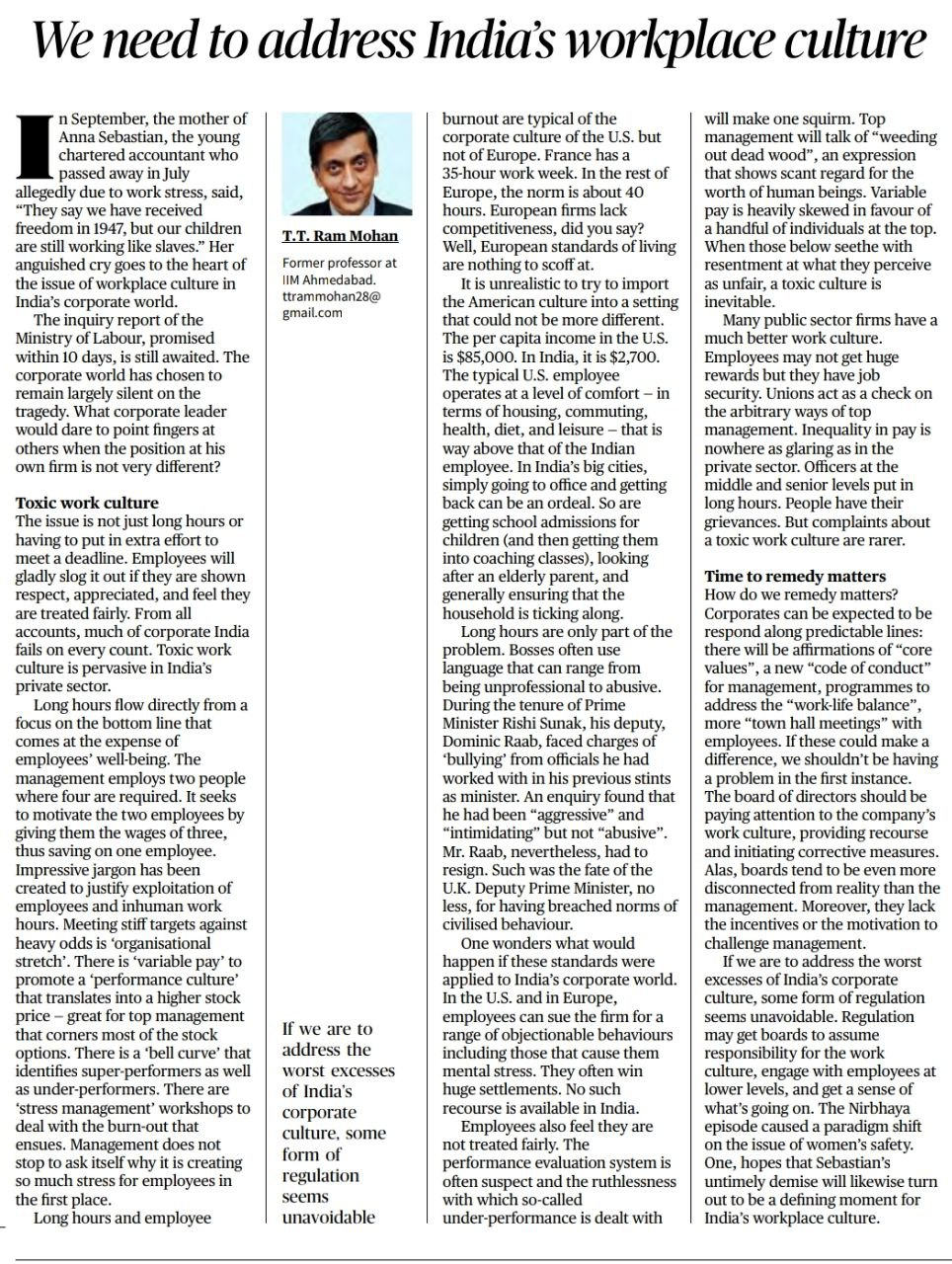1. Into India's Corporate Work Culture
Introduction
The article highlights the toxic work culture prevalent in India’s corporate sector, with a focus on employee exploitation, poor work-life balance, and a lack of concern for mental well-being. A recent incident involving a young accountant’s death due to overwork underscores the urgency of reform in workplace practices.
- Issues in India’s Corporate Work Culture
- Exploitation of Workforce: Employees often work long hours with unrealistic deadlines and high targets. Overburdening employees leads to stress and burnout.
- Low Emphasis on Employee Welfare: The primary focus remains on profit margins and stock prices, sidelining employees’ well-being.
- Workforce Mismanagement: Companies tend to employ fewer people than necessary, demanding more from each individual without adequate compensation.
- Lack of Supportive Policies: Unlike the U.S. or European countries, there are no strict work-hour regulations. European nations emphasize work-life balance, with set work hours, unlike India’s “always-on” culture.
- Absence of Mental Health Support: There are few recourses available for employees experiencing mental stress, as the focus on employee well-being is minimal.
- Reasons for Toxic Culture
- Top-Down Hierarchical Structure: Decision-making and privileges are heavily skewed towards top management, with little regard for employee grievances.
- Performance-Driven Culture: Companies emphasize ‘performance culture,’ which often translates into high stock prices at the cost of employee well-being.
- Weak Regulation and Oversight: There is a lack of enforceable regulations that prioritize employee welfare or set limits on working hours, unlike in Western countries.
- Implications of a Toxic Work Culture
- Decreased Employee Satisfaction: Employees experience high stress, anxiety, and lack of job security, leading to lower productivity and higher turnover rates.
- Health Consequences: Continuous exposure to a stressful environment leads to both mental and physical health issues, which can sometimes be fatal.
- Social Consequences: The lack of time for family and social life impacts employees’ overall well-being and quality of life.
- Potential Solutions
- Regulatory Reforms: Introducing regulations that mandate reasonable working hours and ensure mental health support.
- Top Management Accountability: Boards should take responsibility for workplace culture, ensuring fair treatment and adequate support for employees.
- Promotion of Work-Life Balance: Adoption of European-style work hours and offering flexible working arrangements can improve employee satisfaction.
- Periodic Evaluations of Work Environment: Regular surveys and assessments to measure employee satisfaction and address grievances.
Conclusion
The article calls for urgent reform to address India’s toxic work culture, suggesting that regulatory changes and management accountability can create a healthier environment. It emphasizes that a paradigm shift, similar to the impact of the Nirbhaya incident on women’s safety, is essential for preventing tragedies like Anna Sebastian’s untimely death.
Mains Practice Question |
Q. “The corporate work culture in India has often been criticized for prioritizing profit over employee welfare. Discuss the factors leading to a toxic work culture in India’s corporate sector and suggest measures to improve work-life balance and employee well-being.” |
2. Big Tech's Accountability Crisis: Addressing Unsafe Online Spaces for Women
Introduction
The article discusses the challenges women face in online spaces due to unchecked content moderation by tech platforms. It highlights how technology, instead of empowering women, has become a tool for misogyny, harassment, and abuse. The case of U.S. Vice President Kamala Harris’s campaign is used to illustrate these issues, along with broader concerns over AI and content regulation.
- Challenges Faced by Women Online
- Personal Attacks and Harassment: Women in high-profile roles, such as Kamala Harris, face targeted harassment and character attacks online. These include memes, deepfakes, and doctored videos aimed at undermining their credibility.
- Objectification and Stereotyping: Women face sexual objectification and sexist remarks, further amplified by AI-generated content that misrepresents and harms their public image.
- Misinformation and Deepfake Technology: AI deepfake videos are increasingly used to manipulate and tarnish the image of women, often for political or personal gains.
- Lack of Accountability from Tech Platforms: Social media platforms claim immunity under ‘safe harbor’ provisions, allowing them to avoid responsibility for harmful content shared by users.
- The Illusion of Empowerment through Technology
- Gender-Neutral Bias in Technology: Although technology is often marketed as empowering, it amplifies existing gender biases, creating a hostile environment for women online.
- AI Reinforcing Stereotypes: Instead of helping, AI often mirrors societal biases, intensifying stereotypes and harassment rather than offering women a voice.
- Failure of Platforms to Moderate Effectively: Content moderation policies are often ineffective, with platforms prioritizing engagement over safety, which leads to the spread of harmful content unchecked.
- Proposed Solutions and Needed Reforms
- Stricter Content Moderation and Accountability: Big Tech should implement proper content moderation policies, ensuring that harmful content is removed quickly.
- User Empowerment through Better Features: Platforms need to develop tools allowing users to report, block, and filter content more effectively to create safer online spaces.
- Government Intervention: Laws and policies should be enacted to hold platforms accountable and protect users from online harassment.
- Inclusion of Women in Technology Development: There’s a need to include women in designing and implementing technology to make digital spaces more inclusive and safe.
Conclusion
The article argues that Big Tech companies need to take responsibility for creating safer online spaces for women by implementing stricter policies and ensuring accountability. As digital spaces become more central to daily life, the safety and dignity of women should be a priority, requiring collaboration between technology developers, policymakers, and users.
Mains Practice Question |
Q: “Online spaces are often unsafe for women due to a lack of effective moderation and accountability by tech platforms. Discuss the role of technology in empowering women and analyze the challenges it poses in terms of online harassment and gender bias. Suggest measures to ensure safer digital spaces for women.”
|



